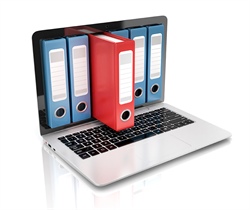
The core purpose of SQL Server is to store data in ways that are efficient for subsequent retrieval and reporting. Many application products use SQL Server for storing information transparent to the person using the software. It has become a favorite of businesses, large and small, for its support of different data requirements.
Relational Databases
The 1980s brought about new ways to store large amounts of data and retrieve it quickly. The relational database was one way, using the spreadsheet as its model. Spreadsheets are composed of rows and columns, as is a relational database. In the database the rows and columns make up tables. Tables and rows are linked to each other such that retrieving information about a company from an "Employer" table can also display all of its associated staff from the "Employee" table.
Talking to a Database
The way in which data is retrieved from these databases is through SQL, or structured query language. In the above example, to display all of the employees in company "ACME Ball Bearings", one would write the SQL query "Select" from Employees where Employer = "Acme Ball Bearings."
Microsoft SQL Server has become a sophisticated storage tool surrounded by a number of services to enhance performance and reliability. While a SQL developer will be intimate with SQL and use it frequently, the average user will never need to know SQL even though this is what is happening in the background of the application.
Features and Editions
The current version of SQL Server includes features to enhance performance, data integrity and security. Instead of a "one-size fits all" approach, multiple editions are available catering to different business needs. Some of the key features of the database include:
- Intelligent use of buffering - Data being retrieved is held in computer memory which is faster to get at than data on a disk drive.
- Massive data storage capabilities - Data can be spread out among several physical devices allowing large databases to be created.
- Multiple concurrent accesses - Many people can work with the same data at the same time. SQL Server managers the order in which information is updated in the database when this happens.
- Support for replication - Databases can be duplicated throughout the network and kept automatically in sync when changes are made.
- Automatic data rollback - Should a situation occur that could result in data being partly updated, SQL Server will rollback changes to a point where data integrity is maintained.
Some of the current Editions of SQL Server available to businesses include:
- Datacenter - For large enterprises needing all of the SQL Server features to support many applications and users.
- Enterprise - For small to medium-sized business that need basic database technology.
- Business Intelligence - For businesses focused on data analysis and reporting.
- Azure - A cloud-based version of Microsoft SQL Server.
- Parallel Data Warehouse (PDW) - For large data warehouse applications.
The Right Database for the Job
With so many options available now in SQL Server, resources such as a SQL Server Developer or a Database Architect are needed to match the database product with the business. There is a version of SQL Server available for every application, from data warehousing to e-Commerce applications. As the technology changes, this database continues to be a foundational component for many applications.
For over 27 years Keene Systems has partnered with clients to provide Microsoft SQL Server solutions that solve complex business problems while increasing margins and lowering cost. Let's talk about your project today!

